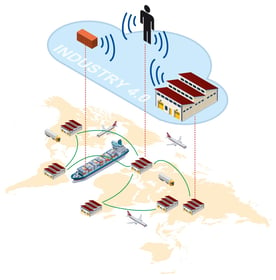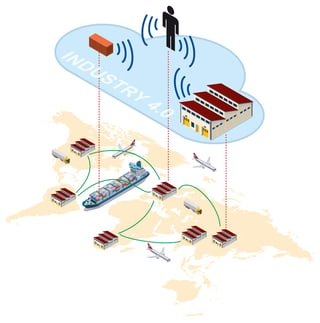How Industry 4.0 Has Changed Global Supply Chain Management
Nick Ostdick - January 24, 2017

 Think about the idea of a blueprint. Essentially, a blueprint is set of plans designed to help carpenters, electricians, plumbers, and others in the construction industry create a building, facility, or space. The blueprint provides various players in the construction of the building with the parameters, constraints, and variables necessary to complete the job on-time and ensure the structure is in sound condition. Now, let’s think about Industry 4.0 in today’s automotive and manufacturing supply chain. By combining such existing processes or platforms like planning, production, warehousing, and transportation into a digital, integrated, Industry 4.0 is a blueprint for a completely optimized production sequence that resonates across each touch point of the value chain, from the factory floor to the customer’s door.
Think about the idea of a blueprint. Essentially, a blueprint is set of plans designed to help carpenters, electricians, plumbers, and others in the construction industry create a building, facility, or space. The blueprint provides various players in the construction of the building with the parameters, constraints, and variables necessary to complete the job on-time and ensure the structure is in sound condition. Now, let’s think about Industry 4.0 in today’s automotive and manufacturing supply chain. By combining such existing processes or platforms like planning, production, warehousing, and transportation into a digital, integrated, Industry 4.0 is a blueprint for a completely optimized production sequence that resonates across each touch point of the value chain, from the factory floor to the customer’s door.
While it’s true Industry 4.0 will test planners and managers in terms of adapting to a new production model, the ways in which Industry 4.0 has already changed the global supply chain are already being felt. OEMs, manufacturers, and suppliers who have embraced Industry 4.0 have not only seen robust growth and enhanced productivity, but they’ve also gained valuable insight into their supply networks which can be leveraged for greater efficiency in both the short and long-term.
With this in mind, here are 3 ways in which Industry 4.0 has changed the global automotive and manufacturing supply chain and the way planners and managers oversee their production networks.
Enhanced production through smart factories
Whether it’s through advanced or intelligent BOM management, Plan for Every Part solutions, or Every Part Every Interval platforms, Industry 4.0 has not only helped reimagined how companies plan production programs, but it’s also helped reshape the geography of the production floor for maximum efficiency. Because smart factories operate on a series of intelligent software platforms that assist in demand capacity planning, job allocation, and inventory management, OEMs are better equipped to fill complex orders and create planning platforms designed to address a variety of constantly-changing constraints or variables. In addition, Industry 4.0 provides planners and managers with powerful reporting capabilities in real-time to review production programs and account for necessary alterations to avoid bottlenecks or breakdowns. Gone are the days when data could not be reviewed until days or weeks after a planned production sequence. With Industry 4.0, planners and managers have the visibility to make informed planning or production decisions as needed.
Advanced analytics
While Industry 4.0 provides planners and managers with a wealth of data and reporting about the efficiency of production programs, the gathering of data itself is not enough of a value proposition in today’s competitive automotive landscape. However, Industry 4.0 allows a space for advanced analytics to enter the conversation as a way to use data to its fullest potential. OEMs now have a platform to sort the data provided by Industry 4.0 into an actionable plan to conduct detailed simulations or ‘what-if’ scenarios, modeling, and forecasting. Advanced analytics also provides OEMs with the flexibility, transparency, and visibility necessary to respond to changes in planned production sequences in order to maintain delivery timetables and ensure the continued movement of component parts throughout the value chain.
Connectivity
Today’s automotive supply chain is comprised of various production facilities and hubs in disparate parts of the world, each of which operates with its own unique set of constraints based on individual orders, location, availability of resources, and other elements. The value proposition of Industry 4.0 resides in connecting these disparate facilities and providing a unified access point to data and reporting at each facility to better understand the holistic supply situation. In such a variant-rich production network, what happens at once facility can impact the other, and Industry 4.0 provides planners and managers with a window into the job scheduling and management, inventory management, warehouse, and transportation strategy across the entire network. This not only increases communication and collaboration, but it also helps break down planning silos, which can be extremely detrimental to understanding a manufacturer's global supply situation.
If a blueprint is essentially a plan for taking raw materials and putting them together in an organized way that creates a sound structure, then Industry 4.0 takes the raw concepts of global supply chain management and unifies them into a plan for a coherent, productive production strategy designed to optimized processes and enhance efficiency. Industry 4.0 may have been more of a hypothetical proposition in the last few years, but today’s automotive and manufacturing supply chain has realized the impact Industry 4.0 can have in a global, competitive marketplace.
LATEST POSTS
- Understand Circular Economy in The Manufacturing Industry
- How Can Industry 4.0 IT Integration Be Achieved Smoothly?
- The Significance of Order Sequencing in Discrete Manufacturing
- How to improve your Supply Chain Management: The Power of Control Towers
- Optimizing Human Resource Scheduling in Manufacturing: A Technological Approach



